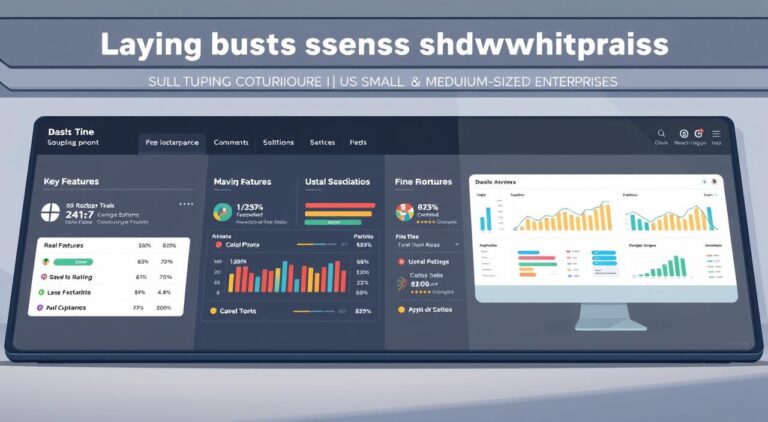Top Productivity Automation Tools for US Businesses
Modern companies face increasing pressure to operate efficiently. Many organizations now use specialized software to handle routine work.
These solutions transform how teams complete daily tasks. They save valuable time and reduce human errors significantly.
Platforms like Rippling and Zapier create seamless workflows. They help businesses scale operations without adding staff.
According to industry reports, over half of IT departments spend substantial time on manual onboarding. Automation cuts this workload dramatically.
These technologies free employees for strategic thinking. They become essential for competitive growth in today’s market.
Key Takeaways
- Automation tools handle repetitive tasks efficiently
- They significantly reduce time spent on manual processes
- Error rates drop when using automated systems
- Scalability improves without proportional staff increases
- Platforms like Rippling unify various business operations
- Teams can focus on strategic work instead of routine tasks
- Modern businesses require these solutions to stay competitive
What Are Productivity Automation Tools?
Software systems that execute repetitive duties automatically represent a significant advancement. These platforms handle rule-based operations with minimal human intervention.
They transform how organizations manage daily operations. Email campaigns, payroll processing, and inventory management become streamlined.
These solutions operate continuously without breaks. They manage data entry, system updates, and customer communications around the clock.
Industry leaders like Rippling demonstrate this power. Their platform unifies workforce management across HR and IT functions.
Zapier connects thousands of applications seamlessly. It creates smooth information flow between different software systems.
Modern automation platforms have evolved from simple scripts to intelligent systems. They now handle complex decision-making through artificial intelligence.
AI-enhanced tools like ChatGPT assist with content creation. They demonstrate how automation continues to advance beyond basic tasks.
These technologies prove particularly valuable for competitive markets. Organizations seeking operational excellence find them indispensable.
According to recent industry analysis, automation adoption correlates strongly with performance metrics. Companies using these solutions report better efficiency outcomes.
The right platform can transform how teams approach their work. It allows focus on strategic initiatives rather than routine processes.
Key Benefits of Implementing Automation
Organizations gain substantial advantages when they integrate smart systems into daily operations. These technologies deliver measurable improvements across multiple business areas.
Significant Time and Resource Savings
Automated platforms handle routine duties faster than manual methods. Entrepreneurs report saving up to 16 hours weekly through these solutions.
Payroll processing that once took hours now completes in minutes. Teams redirect saved hours toward strategic initiatives and creative work.
Enhanced Operational Accuracy and Consistency
Systems like Rippling maintain perfect compliance across thousands of calculations. They eliminate human errors in repetitive financial processes.
Data entry mistakes drop significantly when automation handles information transfer. This ensures reliable reporting and decision-making.
Improved Customer Experience and Engagement
Automated responses provide immediate acknowledgment of customer inquiries. HubSpot workflows nurture leads with personalized content automatically.
Consistent service quality builds trust and loyalty among clients. Engagement metrics improve when responses happen without delays.
Reduction in Operational Costs
Labor expenses decrease when systems handle volume-intensive tasks. QuickBooks automates invoicing, reducing administrative overhead substantially.
Error-related costs diminish through precise automated processing. These savings directly impact bottom-line performance.
Scalability for Business Growth
Platforms like UiPath manage increased workload without additional hiring. They process high-volume tasks during growth phases efficiently.
Expansion becomes more manageable when systems adapt to higher demands. This flexibility supports sustainable development and market responsiveness.
How to Choose the Right Automation Tools for Your Needs
Choosing digital assistants that align with operational requirements involves systematic assessment. The right selection can transform how your organization handles daily operations.
Begin by identifying repetitive tasks that consume valuable time. Look at areas like employee onboarding, invoice processing, or customer communications.
Evaluate integration capabilities carefully. Platforms like Zapier connect with over 6,000 applications, ensuring smooth information flow between systems.
Consider scalability from the start. Solutions like Rippling grow alongside your organization, eliminating the need for frequent platform changes.
Key factors to evaluate include:
- Business needs assessment – Document time-consuming processes that could benefit from digital assistance
- Integration requirements – Ensure new platforms connect with existing CRM and management software
- User accessibility – No-code options like Monday.com empower teams without technical expertise
- Cost analysis – Compare free plans against enterprise pricing while calculating potential ROI
Trusted platforms like Microsoft Power Automate offer robust solutions for Office 365 environments. Their established reputation provides confidence in long-term reliability.
Focus on tools that enhance team collaboration and data management. The best solutions simplify complex workflows while maintaining security standards.
Calculate potential time savings against investment costs. Many organizations find automation pays for itself within months through reduced manual labor.
Strategic tool selection focuses on long-term operational improvement rather than immediate convenience. The right choice supports sustainable growth and adaptability.
Prioritize solutions that offer comprehensive support and training resources. Successful implementation often depends on proper onboarding and ongoing assistance.
Test platforms through free trials before committing. Hands-on experience reveals how well each solution handles your specific operational requirements.
Remember that the most expensive option isn’t always the best fit. Focus on finding software that addresses your unique business processes effectively.
Comprehensive HR, IT, and Finance Automation Platforms
Enterprise organizations require integrated solutions that span multiple departments. Comprehensive platforms deliver unified control across human resources, technology systems, and financial operations.
These systems eliminate departmental silos through seamless information sharing. They create cohesive workflows that enhance organizational efficiency.
Rippling: Unified Workforce Management
Rippling offers a revolutionary approach to employee lifecycle management. This powerful system handles everything from hiring to separation seamlessly.
The platform processes payroll in approximately 90 seconds. It automatically provisions devices and ensures compliance across all jurisdictions.
Key capabilities include:
- Automated onboarding and offboarding procedures
- Integrated payroll processing with error-free execution
- IT device management and software deployment
- Custom workflow creation for unique business needs
Rippling’s pricing follows a per-employee model. This scalable approach makes it suitable for growing organizations.
Companies report significant time savings in IT departments. The platform reduces manual setup tasks by over 80% according to internal studies.
Lark: All-in-One Collaboration and Automation Suite
Lark combines communication, documentation, and process automation. This integrated environment supports team collaboration while automating routine tasks.
The platform features Base for trigger-based actions and Approval for workflow management. It incorporates AI-powered summaries through OpenAI integration.
Notable features:
- Real-time chat and document collaboration
- Automated workflow triggers and webhook support
- Custom dashboards for process monitoring
- AI-assisted content generation and summarization
Lark offers a free Starter plan for teams up to 20 users. The Pro plan costs $12 per user monthly, with custom Enterprise solutions available.
Use cases include sales lead routing and finance approval processes. The platform handles end-to-end automation across departmental boundaries.
Integrated platforms transform how organizations manage cross-functional operations. They create efficiency gains that individual tools cannot achieve alone.
Both solutions demonstrate the power of comprehensive automation. They provide American companies with robust platforms for sustainable growth.
These systems deliver consistency and scalability across all operations. They represent the future of integrated business management.
Workflow and App Integration Automation Tools
Digital platforms that connect different applications create powerful operational harmony. These solutions eliminate manual data transfers between systems.
They establish smooth information flow across your entire software ecosystem. This connectivity transforms how organizations handle cross-platform tasks.
Modern integration platforms require no technical expertise. They empower teams to build sophisticated connections through simple interfaces.
Zapier: Connecting Thousands of Apps
Zapier stands as the market leader in application integration. It supports over 6,000 different software connections.
The platform enables multi-step workflows between various systems. For example, it can sync Shopify orders directly to Google Sheets automatically.
Key advantages include:
- No-code workflow creation for non-technical users
- Free plan available for basic automation needs
- Extensive library of pre-built application integrations
- Reliable data synchronization between platforms
Many companies use Zapier for CRM and email tool connections. It automates customer data entry without manual intervention.
This reduces administrative workload significantly. Teams report saving hours previously spent on repetitive transfers.
Microsoft Power Automate: For Office 365 Ecosystems
Microsoft’s solution excels within Office 365 environments. It integrates seamlessly with Teams, Dynamics, and SharePoint.
The platform features AI Builder for intelligent process handling. It can scan invoices and extract relevant data automatically.
Pricing starts at $15 monthly per user. This makes it accessible for organizations already using Microsoft products.
Common implementations include contract approvals in SharePoint. The system routes documents through approval chains without manual tracking.
It ensures compliance while accelerating decision processes. This combination proves valuable for regulated industries.
IFTTT: Simple Conditional Automations
IFTTT specializes in straightforward “if this, then that” logic. It perfects basic conditional actions across devices and applications.
The platform excels at personal productivity and simple business functions. It often handles social media cross-posting automatically.
Users appreciate its intuitive mobile interface. It requires minimal setup for immediate results.
Integration platforms have democratized automation for all organization sizes. They remove technical barriers that once limited digital transformation.
These three solutions represent different approaches to connectivity. Each serves distinct organizational needs and technical requirements.
They collectively demonstrate how modern systems eliminate manual data handling. This advancement allows teams to focus on value-added activities.
Robotic Process Automation (RPA) for Complex Tasks
When routine duties become too intricate for basic solutions, specialized technology takes over. Robotic process automation represents the next evolution in digital workforce assistance.
These advanced systems handle complicated assignments that once required human judgment. They excel where consistency and precision matter most.

RPA technology uses software robots to mimic human actions within digital environments. These bots perform rule-based assignments across multiple applications.
They interact with legacy systems that lack modern integration capabilities. This makes them perfect for organizations with established technology infrastructure.
UiPath: Enterprise-Grade RPA and AI
UiPath stands as the industry leader for sophisticated automation needs. This powerful platform combines robotic process automation with artificial intelligence.
It handles high-volume, repetitive workflows across various departments. The system manages everything from data extraction to compliance reporting.
Key capabilities include:
- Processing insurance claims with automatic validation checks
- Extracting information from unstructured forms and documents
- Updating legacy systems without API dependencies
- Handling large-scale data migration projects
UiPath’s AI components understand context and make intelligent decisions. They process unstructured information like emails and scanned documents.
The platform works seamlessly with existing enterprise software investments. This eliminates the need for costly system replacements.
Organizations using UiPath report 80% reduction in processing time for complex assignments. Error rates drop to near zero through consistent automated execution.
Regulated industries benefit tremendously from this technology. Banking institutions automate compliance reporting with perfect accuracy.
Healthcare organizations process patient records while maintaining strict privacy standards. The system handles sensitive information with reliable security protocols.
Scalability remains one of UiPath’s strongest advantages. It manages increasing volumes without additional configuration.
This makes it ideal for growing organizations with expanding operational needs. The platform grows alongside your business requirements.
Implementation requires careful planning but delivers substantial returns. Most enterprises recover their investment within the first year of use.
UiPath represents the gold standard for complex automation challenges. It transforms how organizations handle their most demanding operational tasks.
No-Code Workflow and Process Automation Platforms
Modern organizations now empower every team member to build custom workflows without technical expertise. These visual platforms transform how companies handle routine operations.
They eliminate the need for programming knowledge entirely. Business teams can design sophisticated automations through intuitive interfaces.
This accessibility revolutionizes digital transformation. Departments gain control over their specific operational needs.
Kissflow: Digital Process Transformation
Kissflow delivers powerful no-code capabilities for enterprise environments. Its drag-and-drop builder simplifies complex workflow creation.
The platform offers prebuilt templates for common business functions. HR onboarding and finance approvals become streamlined instantly.
Key features include:
- Real-time dashboards for process monitoring
- Custom forms for data collection
- Automated routing for approval chains
- Comprehensive analytics and reporting
Pricing starts at $18 per user monthly. This provides excellent value for mid-sized organizations.
Companies use Kissflow for purchase request automation. The system routes requests through appropriate approval channels automatically.
It ensures compliance while accelerating decision cycles. This combination proves valuable for growing enterprises.
Smartsheet: Spreadsheet-Style Automation
Smartsheet combines familiar spreadsheet interfaces with powerful automation capabilities. Teams already comfortable with Excel adapt quickly.
The platform automates task assignments, reminders, and status updates. It maintains the flexibility of spreadsheets while adding workflow intelligence.
Notable capabilities:
- Automated alert systems for project delays
- Custom approval workflows for stakeholder review
- Real-time performance tracking dashboards
- Integrated reporting for management visibility
Pricing begins at $7 per user monthly. This affordable entry point makes automation accessible for smaller teams.
Project managers use Smartsheet for delay notifications. The system automatically alerts stakeholders when timelines change.
This maintains project momentum without manual follow-ups. Teams stay informed through automated communications.
No-code platforms have transformed who can drive digital innovation. Business analysts and department managers now lead automation initiatives directly.
These solutions deliver significant time savings through reduced manual work. They improve process visibility across entire organizations.
American companies prioritizing ease of use should evaluate both platforms. Each offers distinct advantages for different operational needs.
Kissflow excels for structured approval processes. Smartsheet shines for project-based workflow management.
Both represent the future of accessible business transformation. They empower teams to innovate without technical constraints.
Marketing and CRM Automation Solutions
Digital platforms now transform how companies interact with potential clients. These systems handle repetitive marketing duties automatically.
They ensure consistent communication while saving valuable time. Teams focus on strategy rather than manual outreach.
Modern solutions create personalized experiences at scale. They respond instantly to customer behaviors and interests.
HubSpot Workflows: Integrated Marketing Automation
HubSpot delivers powerful campaign management through its Marketing Hub. This platform automates behavior-based communications seamlessly.
It scores leads based on engagement and readiness. The system syncs perfectly with HubSpot’s CRM for unified customer data management.
Pricing begins at $45 monthly per user. This investment quickly pays for itself through improved conversion rates.
Key capabilities include:
- Automated email sequences triggered by specific actions
- Lead nurturing based on content engagement patterns
- CRM integration for seamless information flow
- Performance analytics for campaign optimization
Companies use these workflows for white paper download follow-ups. The system automatically sends relevant content to interested prospects.
This maintains engagement without manual intervention. Response times improve dramatically through instant communication.
Zoho One: Suite-Wide Business Automation
Zoho One provides comprehensive solutions across all departments. It connects sales, marketing, and support functions effortlessly.
The platform ensures consistency in customer interactions. Teams access unified information for better decision-making.
Notable features:
- Automated lead assignment based on territory rules
- Follow-up task creation for sales representatives
- Marketing analytics integrated with sales performance
- Cross-departmental workflow automation
Organizations automate sales lead distribution through Zoho. The system routes opportunities to appropriate team members instantly.
It creates follow-up tasks and reminders automatically. This eliminates missed opportunities and delays.
Marketing automation platforms deliver measurable ROI through improved lead conversion and customer retention. They transform how organizations scale their growth efforts.
Both solutions demonstrate the power of integrated marketing automation. They help American companies build stronger customer relationships.
These platforms provide scalable solutions for growing organizations. They ensure consistent engagement across all touchpoints.
Teams gain valuable insights from centralized customer data. This information drives smarter marketing decisions and strategies.
Project and Task Management Automation
Organizations seeking to streamline their operational processes often turn to specialized platforms. These systems transform how teams coordinate and execute their daily assignments.
Visual interfaces and rule-based logic make complex coordination simpler. They eliminate manual follow-ups and status updates completely.
Monday.com: Visual Work Operating System
Monday.com revolutionizes how teams visualize and handle their assignments. This platform offers colorful boards that show progress at a glance.
Automation rules trigger status changes and notifications automatically. Dashboards update in real-time without manual intervention.
Key features include:
- Automatic task status updates based on predefined conditions
- Custom notification systems for deadline reminders
- Visual progress tracking across multiple initiatives
- Integration capabilities with other business software
Pricing starts with a free plan for basic needs. Paid options begin at $10 per user monthly for expanded capabilities.
Companies use this system for automated project progress reporting. It ensures stakeholders receive updates without manual preparation.
Asana: Rules-Based Project Automation
Asana brings sophisticated rule engines to team coordination. It handles task assignments and dependencies through automated workflows.
The platform excels at recurring processes and milestone tracking. It maintains consistency across repeated initiatives.
Notable capabilities:
- Automatic task assignment based on workload or expertise
- Due date adjustments according to project timelines
- Dependency management for complex initiative sequences
- Template creation for repeatable workflow patterns
Subscription plans start at $10.99 per user monthly. This investment delivers significant time savings through reduced manual coordination.
Marketing teams automate content calendar management through Asana. The system handles publishing schedules and assignment rotations.
Trello: Simple Board and Card Automation with Butler
Trello offers straightforward visual organization through its card-based system. Butler provides powerful automation for routine card management.
This approach works perfectly for smaller groups or individual productivity. It simplifies complex processes through intuitive automation.
Key advantages:
- Automatic card movements between lists based on triggers
- Reminder systems for upcoming deadlines or assignments
- Template creation for consistent project setups
- Simple integration with popular productivity applications
A free plan accommodates basic needs effectively. Paid options begin at $5 monthly per user for advanced features.
Teams use Trello for automatic task assignments when cards move lists. This maintains balanced workloads without manual intervention.
These platforms demonstrate how visual interfaces and rule-based systems transform project coordination. They reduce administrative overhead while improving team collaboration significantly.
American organizations managing multiple initiatives should evaluate these solutions. Each offers distinct advantages for different coordination needs.
They collectively represent the future of efficient team management. These systems ensure deadlines get met through automated tracking and reminders.
Specialized Automation for Content and Communication
Creative teams now leverage intelligent platforms to handle writing and editing duties. These systems transform how organizations produce marketing materials and customer communications.
AI-powered solutions like Jasper and Anyword generate draft copy instantly. They analyze audience preferences to create targeted messaging.
ChatGPT assists with idea generation and content outlines. It helps writers overcome creative blocks and maintain consistent output.
Key content automation benefits include:
- Rapid draft creation for blogs and social media posts
- Consistent brand voice across all communication channels
- Error reduction through automated proofreading checks
- Time savings for marketing teams focusing on strategy
Grammarly enhances written communication accuracy automatically. It suggests improvements for clarity and professional tone.
Descript revolutionizes video editing through transcription technology. Editors can manipulate footage by editing text transcripts directly.
Organizations using these tools report 40% faster content production cycles. They maintain quality standards while scaling output volume significantly.
Practical applications include automated blog post generation. AI platforms create initial drafts that writers refine and personalize.
Email communication improves through tone enhancement suggestions. Teams maintain professional standards across all customer interactions.
Podcast editing becomes faster with transcription-based tools. Producers edit audio by manipulating text, saving hours of manual work.
These solutions demonstrate how specialized automation transforms creative processes. They empower teams to achieve more with existing resources.
Understanding Pricing Models and Total Cost of Ownership
When evaluating operational efficiency solutions, understanding the complete financial picture extends beyond simple subscription fees. Different platforms offer varied approaches to pricing that suit diverse organizational needs.
Free options exist for basic functionality. Zapier provides five automated workflows monthly at no cost. This allows small teams to test capabilities before committing financially.
Tiered pricing serves growing organizations effectively. Lark’s Pro plan costs $12 monthly per user. This scalable approach matches expanding operational requirements.
Enterprise solutions often feature custom pricing. These tailored plans address complex organizational structures. They include dedicated support and advanced security features.
Total ownership costs encompass more than software expenses. Implementation time and training investments contribute significantly. However, these upfront costs yield substantial long-term returns.
Labor savings quickly offset initial investments. Reduced error rates further enhance financial benefits. Companies report recovering costs within months through efficiency gains.
Rippling demonstrates per-employee pricing advantages. This model proves cost-effective compared to multiple separate tools. Unified platforms eliminate integration expenses and compatibility issues.
Lark’s savings calculator illustrates dramatic financial impact. Organizations with 100 employees save approximately $25,200 annually. This represents significant return on investment through streamlined operations.
Businesses implementing these solutions typically recover their investment within six months. The combination of time savings and error reduction creates compelling financial justification.
Entrepreneurs report saving 16 hours weekly through effective implementation. This productivity boost directly translates to increased revenue generation. Strategic work replaces routine administrative tasks.
When budgeting for digital transformation, consider both immediate and long-term financial implications. The right automation tools deliver value that far exceeds their cost. Smart investment in these platforms drives sustainable growth and competitive advantage.
American organizations should evaluate their specific operational needs. Choosing the appropriate pricing model ensures optimal financial outcomes. Proper planning maximizes return on investment while minimizing total cost of ownership.
Best Practices for a Successful Automation Implementation
Organizations can maximize their investment in process automation by following proven implementation methodologies. These strategies ensure smooth transitions and deliver measurable improvements across departments.
Proper planning prevents common pitfalls during digital transformation. It creates sustainable efficiency gains that support long-term growth.

Start with High-Impact, Repetitive Processes
Begin your automation journey by targeting time-consuming manual tasks. Focus on areas like employee onboarding or invoice processing that drain resources.
These high-impact areas deliver quick wins and demonstrate immediate value. Rippling’s research shows payroll automation can save up to 80% of manual processing time.
Customer follow-up systems also offer substantial returns. Automated responses improve engagement while reducing administrative burdens.
Document and Map Existing Workflows First
Thorough documentation forms the foundation for successful automation. Map current processes to identify bottlenecks and improvement opportunities.
This analysis reveals hidden inefficiencies in your operations. It ensures the new system addresses actual pain points rather than perceived issues.
Workflow mapping creates clarity for implementation teams. It guides tool selection and configuration decisions throughout the project.
Prioritize User-Friendly and Scalable Tools
Select platforms that team members can adopt easily. Solutions like Monday.com offer intuitive interfaces that require minimal training.
Scalability ensures your investment grows with your organization. UiPath handles increasing volumes without performance degradation.
Consider integration capabilities during tool evaluation. The right software should connect seamlessly with existing systems.
Manage Organizational Change and Train Your Team
Successful implementation requires addressing human factors directly. Involve team members in planning to build ownership and reduce resistance.
Comprehensive training programs ensure smooth adoption across departments. They empower employees to leverage new capabilities effectively.
Celebrate early successes to maintain momentum throughout the transition. Recognition reinforces the value of automation investments.
Companies that involve teams in automation planning report 60% higher adoption rates. Comprehensive training reduces implementation timelines by approximately 40%.
These practices create sustainable automation benefits that support competitive advantage. They transform how organizations approach digital transformation initiatives.
American companies following this methodology achieve faster ROI. They build operational excellence through strategic technology integration.
The Future of Business Automation
Tomorrow’s competitive landscape will demand smarter operational approaches through advanced automation. These technologies continue evolving beyond basic task handling into intelligent decision-making systems.
Artificial intelligence integration represents the most significant development. Platforms like Lark already incorporate OpenAI for intelligent summarization and content generation.
Predictive analytics will transform how companies forecast demand and allocate resources. Natural language processing enables systems to understand and respond to complex queries.
No-code platforms are becoming increasingly sophisticated. They empower non-technical users to create complex workflows without programming knowledge.
This accessibility revolutionizes who can drive digital transformation. Department managers and business analysts now lead automation initiatives directly.
Automation expands into strategic areas like data analysis and customer sentiment tracking. These systems handle tasks that once required human judgment and expertise.
The most successful organizations will be those that integrate automation into their strategic planning processes. These technologies become partners in decision-making rather than just tools for efficiency.
Zapier Agents demonstrate this evolution perfectly. They allow artificial intelligence to work across multiple applications simultaneously.
This capability hints at future possibilities where systems anticipate needs and initiate actions autonomously. The boundary between assistance and autonomy continues blurring.
Companies must prepare for these advancements to maintain competitive advantage. Early adoption provides significant benefits in market responsiveness and operational agility.
Investment in flexible automation platforms ensures readiness for coming innovations. The right foundation supports integration of emerging technologies as they develop.
These trends make automation essential for future-proofing organizations. They transform how teams approach challenges and opportunities in evolving markets.
Strategic implementation today positions companies for success tomorrow. The future belongs to those who harness these technologies effectively.
Conclusion
Smart platforms revolutionize how teams operate today. They handle routine duties with precision and speed.
These systems save valuable hours every week. They cut errors dramatically while improving customer interactions.
Leading solutions like Rippling unify complex operations. Zapier connects apps seamlessly across your workflow.
Adopting these technologies is no longer optional. It’s essential for staying competitive and scaling efficiently.
Begin by automating high-impact processes first. Choose user-friendly platforms that grow with your needs.
Start your transformation journey today. The right investment pays for itself quickly through massive efficiency gains.






